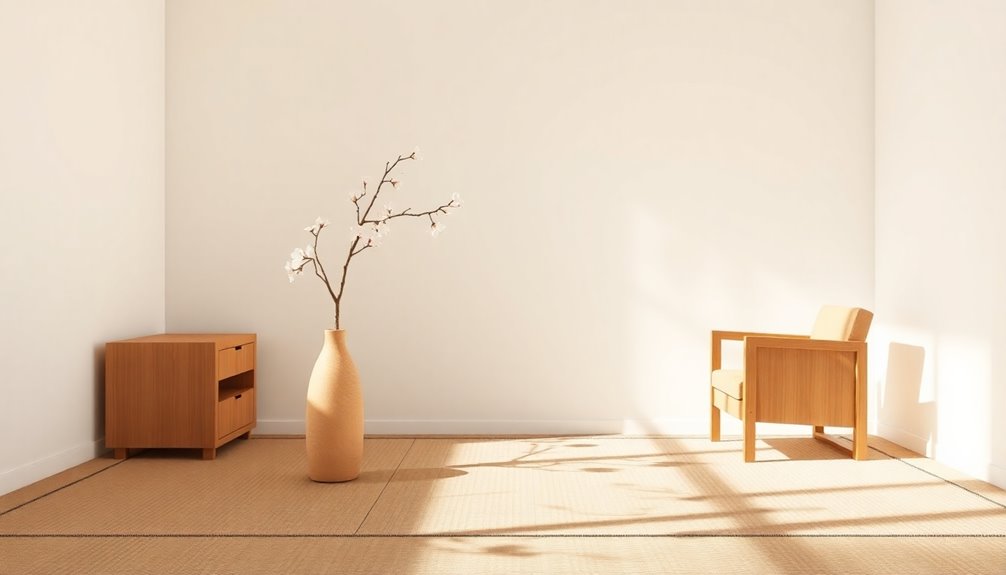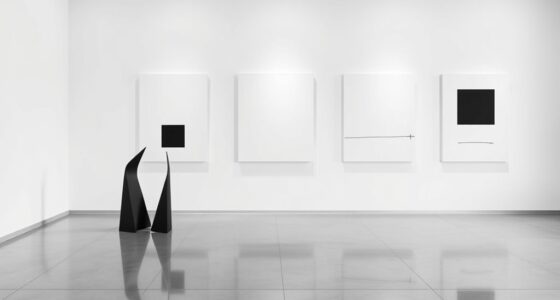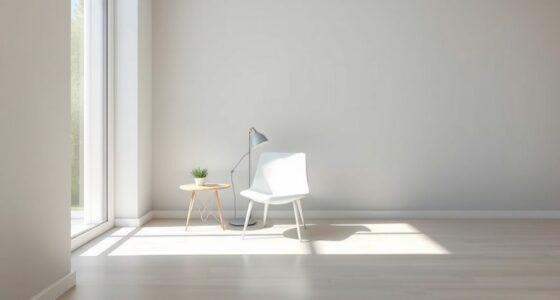Did you know that over 75% of people in urban areas report feeling overwhelmed by clutter? As you explore the principles of Japanese minimalism in contemporary design, you'll uncover how this aesthetic not only promotes simplicity but also fosters a sense of calm. The unique philosophies behind this movement challenge conventional notions of beauty and functionality. What insights might you gain about creating serene spaces that resonate with your own lifestyle?
Key Takeaways
- Japanese minimalism emphasizes simplicity and functionality, creating serene spaces that promote mindfulness in contemporary design.
- The use of natural materials like wood, bamboo, and stone fosters a connection to the environment and enhances aesthetic appeal.
- Wabi-Sabi principles celebrate imperfection and aging, encouraging emotional connections with objects in modern design.
- Clean lines and neutral color palettes eliminate clutter, resulting in inviting atmospheres that inspire peace and clarity.
- The integration of sustainable practices reflects a growing interest in environmental responsibility within contemporary minimalist living spaces.
The Essence of Japanese Minimalism
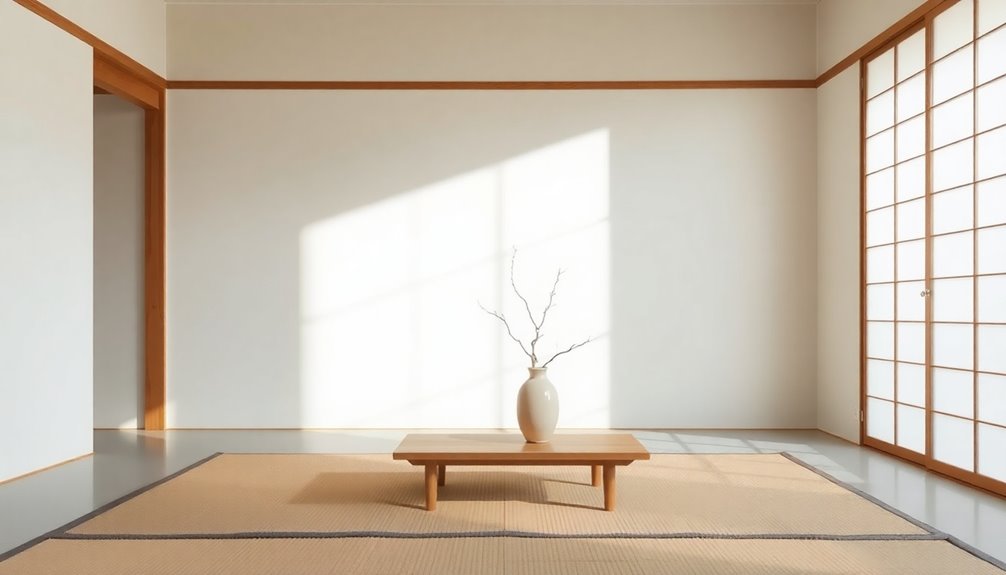
Japanese minimalism embodies a philosophy that prioritizes simplicity and functionality, allowing you to experience a sense of calm in your surroundings.
By focusing on the intentional use of natural materials like wood, bamboo, and stone, you create spaces that resonate with nature and promote serenity.
The design emphasizes negative space, or Ma, inviting you to appreciate the beauty of balance and harmony through thoughtful gaps and intervals.
This approach eliminates unnecessary elements, leading to a clean aesthetic that fosters comfort.
As you embrace this minimalist lifestyle, you'll find that it reflects a modern trend towards mindful living, where each choice you make in your environment enhances your overall well-being while honoring traditional Japanese principles. Additionally, incorporating natural materials into your decor can enhance the serene atmosphere typical of both Japanese minimalism and farmhouse design.
Philosophical Foundations: Wabi-Sabi and Shibumi
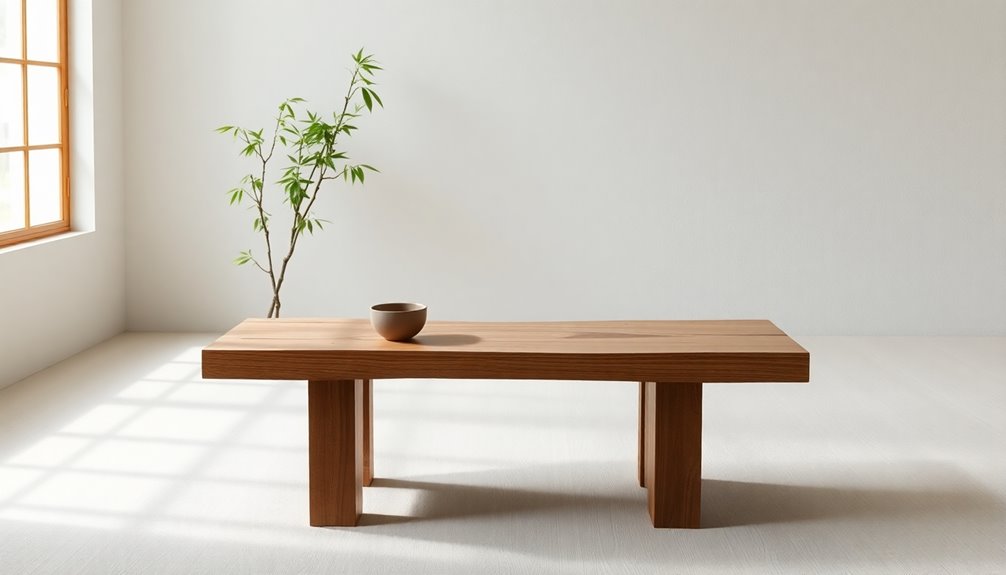
To appreciate Japanese minimalism fully, you'll want to explore the principles of Wabi-Sabi and the essence of Shibumi.
Wabi-Sabi invites you to find beauty in imperfection and the natural aging of materials, while Shibumi embodies a quiet elegance that values simplicity and restraint.
Together, these philosophies promote a mindful connection to your environment, shaping a tranquil space that resonates with harmony. Additionally, incorporating elements of essential oil safety can enhance your serene atmosphere while ensuring a safe and pleasant experience.
Understanding Wabi-Sabi Principles
At the heart of Japanese design lies Wabi-Sabi, an aesthetic philosophy that embraces imperfections and the fleeting nature of life. This approach encourages you to appreciate the minimalist aesthetic, focusing on natural materials and their unique qualities. By celebrating rustic simplicity, you foster emotional connections with objects that tell a story. Wabi-Sabi invites you to find beauty in the transience of life and the authenticity of handmade items, reflecting nature's irregularities. Additionally, the principles of Wabi-Sabi align with the importance of emotional regulation, as they promote a deeper understanding of our reactions to the world around us.
| Wabi-Sabi Principles | Characteristics |
|---|---|
| Embracing Imperfection | Celebrating flaws |
| Transience | Appreciating the moment |
| Natural Materials | Using organic elements |
| Elegant Simplicity | Minimalist design |
| Emotional Connections | Narratives behind objects |
The Essence of Shibumi
Shibumi captures the essence of subtle elegance and restraint, offering a profound counterpoint to the chaos of modern life.
Rooted in Japanese aesthetics, shibumi embodies a minimalist approach, celebrating the beauty of the natural world through muted colors and simple designs. It emphasizes the importance of negative space (ma), suggesting that less really is more. By removing distractions, you can appreciate the design elements more fully.
This philosophy aligns closely with wabi-sabi, which honors imperfection and the passage of time. Historical symbols, like unripe persimmons from the Muromachi period, highlight the allure of simplicity.
In contemporary design, shibumi inspires a timeless aesthetic, valuing craftsmanship and the organic characteristics of materials, allowing nature's beauty to shine through. Additionally, the principles of vibrational alignment found in the Law of Attraction can enhance the experience of embracing minimalism by fostering a mindset that appreciates simplicity and presence.
Key Characteristics of Japanese Minimalist Design
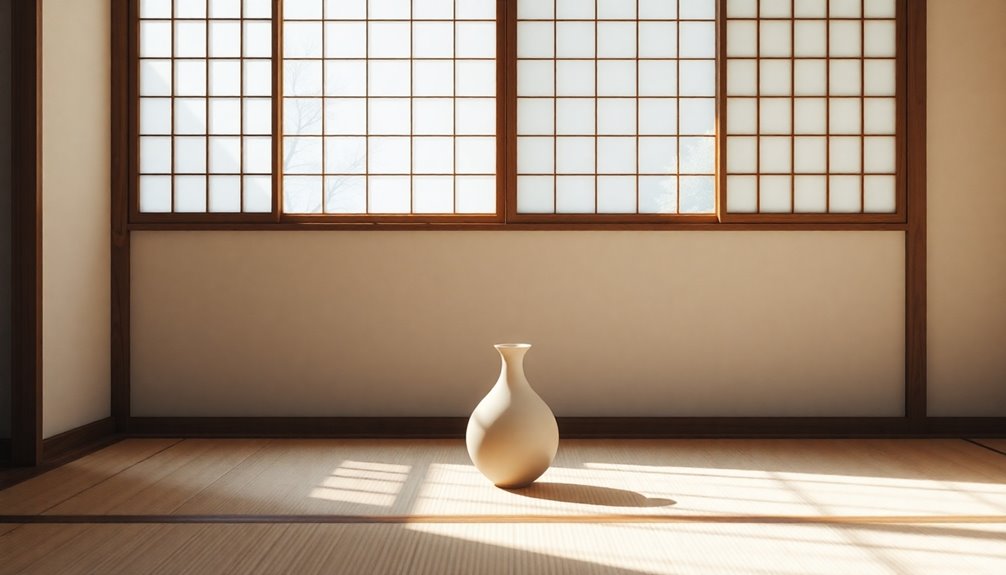
When you explore Japanese minimalist design, you'll notice its core characteristics: simplicity and functionality that prioritize what truly matters.
Natural materials and textures create a harmonious connection to the environment, while balance and negative space enhance the overall tranquility of the space.
Together, these elements form an inviting atmosphere that encourages peace and clarity. Additionally, the use of natural materials reflects a commitment to sustainability and a deeper connection to the surrounding environment.
Simplicity and Functionality
Emphasizing simplicity and functionality, Japanese minimalist design transforms spaces into serene environments that prioritize well-being. You'll notice clean lines and neutral color palettes that eliminate unnecessary elements, creating harmonious living areas. The concept of Ma, or negative space, plays an essential role in enhancing balance and tranquility. Each element serves a distinct purpose, fostering a connection to nature through the use of natural materials like wood and stone. Selecting fixtures with water efficiency features can further enhance the sustainable aspect of minimalist designs.
| Key Elements | Description | Importance |
|---|---|---|
| Simplicity | Focus on fewer, essential items | Reduces clutter |
| Functionality | Every piece serves a purpose | Enhances usability |
| Clean Lines | Straightforward design aesthetics | Creates visual calmness |
| Natural Materials | Use of organic textures | Connects spaces with nature |
| Negative Space | Strategic gaps in design | Promotes a sense of peace |
Natural Materials and Textures
Natural materials and textures are at the heart of Japanese minimalist design, creating a powerful connection to nature and enhancing the overall ambiance of a space.
You'll find an emphasis on natural materials like wood, bamboo, stone, and paper, which promote sustainability while inviting the outdoors in. Neutral colours—whites, greys, and natural wood tones—create a calming atmosphere that showcases the beauty of these materials.
Textures are essential, with untreated wood and stone surfaces evoking authenticity and harmony. Incorporating plants and water features not only adds natural elements but also improves air quality, enhancing serenity. This careful attention to detail reflects the principles of Wabi-Sabi, celebrating simplicity and the beauty of imperfection in design. Additionally, the use of herbal remedies can further enhance the tranquility of these spaces, promoting a holistic connection with nature.
Balance and Negative Space
In Japanese minimalist design, balance and negative space play a crucial role in crafting an atmosphere of tranquility.
You'll notice how the intentional use of negative space, or Ma, enhances each object's purpose, allowing it to shine in its simplicity.
Visual hierarchy draws your eye to primary elements, contrasted beautifully against calm, neutral color palettes of whites, greys, and natural wood tones.
This arrangement not only promotes a serene environment but also emphasizes the harmony inherent in minimalism in Japanese design.
By incorporating natural materials like wood, stone, and paper, you're adding texture that further solidifies the sense of balance and calm.
Embracing these principles transforms your space into a peaceful retreat. Additionally, the use of sustainable materials in design can enhance both luxury and environmental responsibility.
The Role of Zen in Contemporary Aesthetics
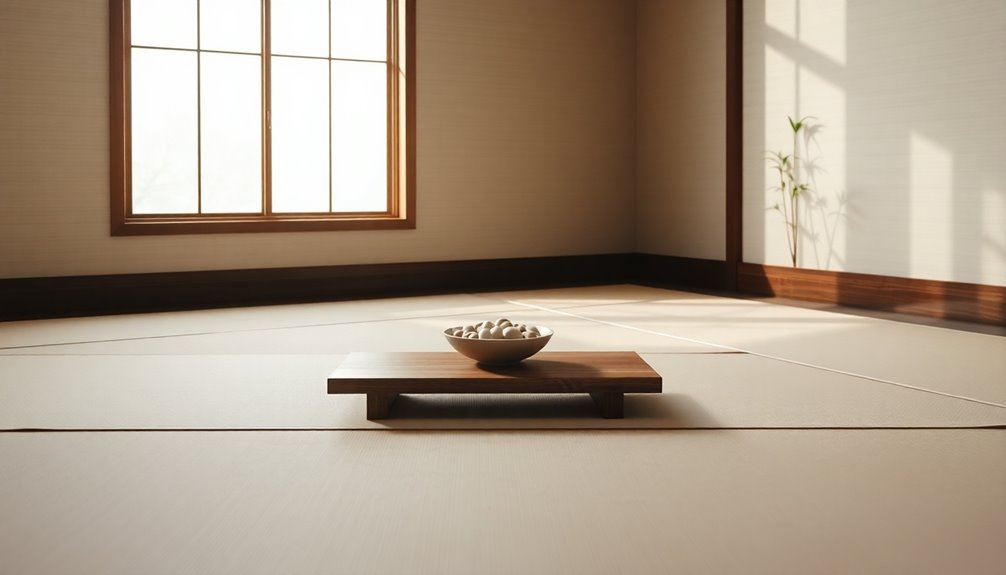
While many contemporary designs aim for visual appeal, the influence of Zen philosophy introduces a deeper layer of meaning, focusing on tranquility and mindfulness.
Zen Buddhism emphasizes the concept of ma, or negative space, which enhances visual aesthetics and creates a sense of calm. Here's how it shapes modern design:
Zen Buddhism highlights the importance of ma, or negative space, fostering tranquility and elevating visual aesthetics in modern design.
- Celebrates simplicity and functionality
- Encourages the use of natural materials
- Embraces asymmetry and imperfection (wabi-sabi)
- Creates serene living environments
- Fosters a connection to nature
Designers like Naoto Fukasawa illustrate these principles, integrating clean lines and harmony in their works. Additionally, the emphasis on unconditional love in relationships can inspire designers to create spaces that foster emotional safety and connection.
Global Impact of Japanese Minimalism
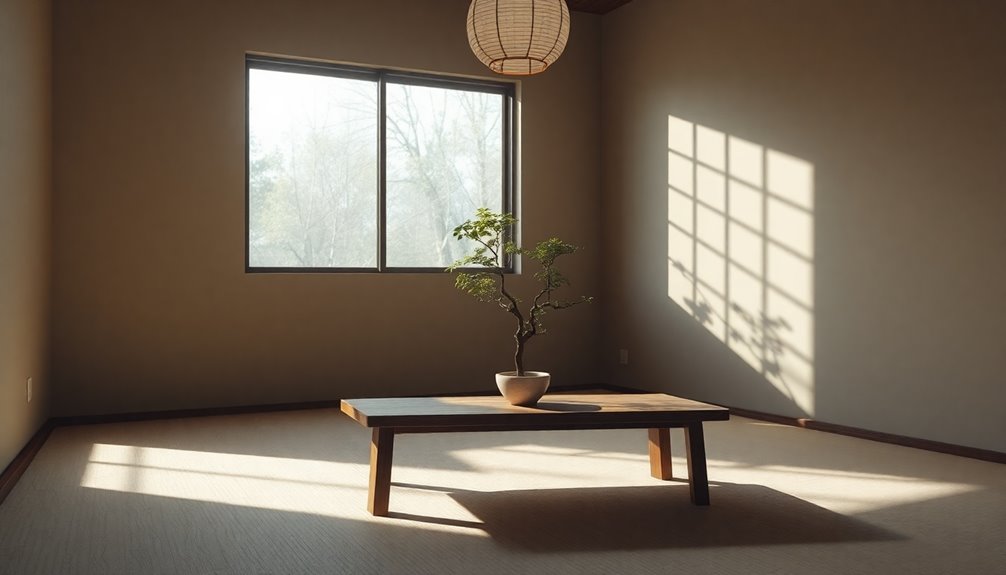
As designers around the world embrace simplicity and functionality, the global impact of Japanese minimalism becomes increasingly evident.
You'll notice its principles woven into various fields, from interior design to fashion and product design. The aesthetic qualities, like the use of natural materials and neutral color palettes, have captivated contemporary architects and designers alike.
Influencers such as Naoto Fukasawa showcase modern Japanese elegance and practicality, prioritizing user experience in award-winning designs.
The rise of lifestyle minimalism, highlighted by figures like Marie Kondo, reflects a growing global interest in mindful living, deeply rooted in traditional Japanese culture.
Adaptations, like the West Wind Estate in California, illustrate how these principles cater to contemporary sustainability and comfort needs, shaping global design trends. Additionally, the focus on natural materials in Japanese minimalism promotes a deeper connection to the environment, emphasizing sustainability in design practices.
Integrating Minimalism Into Modern Living Spaces
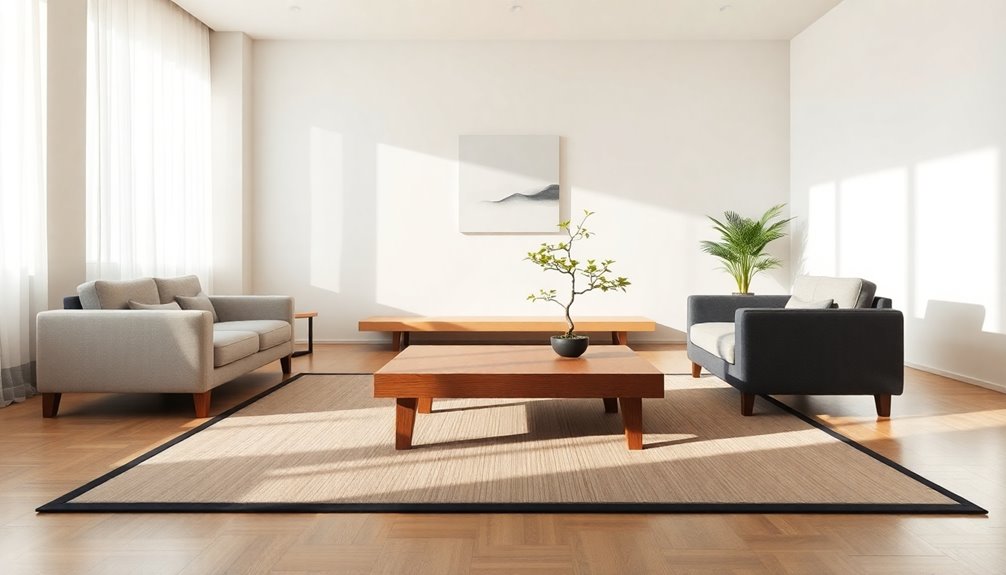
Embracing Japanese minimalism in your modern living space transforms it into a sanctuary of tranquility and balance.
Embracing Japanese minimalism creates a serene sanctuary, fostering tranquility and balance in your living space.
This minimalist approach focuses on integrating natural materials and creating negative space, which promotes relaxation and mindfulness.
Here are some key elements to reflect upon:
- Use neutral color palettes, primarily whites and natural tones.
- Incorporate natural materials like wood, stone, and paper.
- Embrace Wabi-Sabi by accepting imperfections and asymmetry.
- Design open floor plans that enhance flow and functionality.
- Support local artisans with handcrafted furniture and decor.
Frequently Asked Questions
What Is Japanese Minimalist Style Called?
The Japanese minimalist style is often called "shibumi." It emphasizes subtle elegance and simplicity, focusing on understated beauty.
You'll notice that key concepts like "wabi-sabi" appreciate imperfection, while "ma" highlights the importance of negative space.
This style prioritizes functionality and eliminates unnecessary elements, promoting a sense of calm and clarity.
Influential designers have helped popularize shibumi, merging traditional elements with modern aesthetics to create a balanced, harmonious environment.
What Is Minimalism in Contemporary Art?
Think of minimalism as the art world's version of decluttering your closet.
In contemporary art, it's all about simplicity and stripping away the excess. You'll notice artists using basic shapes and a limited color palette, inviting you to focus on what truly matters.
This approach challenges traditional notions of art and encourages you to engage more deeply, reflecting a desire for clarity and highlighting the beauty in the unadorned.
What Is the Japanese Minimalist Approach?
The Japanese minimalist approach centers on simplicity and functionality.
You'll find it emphasizes essential elements while removing unnecessary features. By celebrating imperfection and transience, it creates a serene atmosphere.
You can appreciate how natural materials like wood and stone foster a connection to nature. Large windows and open spaces invite light, enhancing tranquility.
Ultimately, this approach encourages mindfulness and contemplation, making your environment a calming retreat from the chaos of everyday life.
What Is the Difference Between Wabi Sabi and Minimalism?
Imagine a cracked teacup that tells a story versus a sleek, uniform mug. That's the essence of the difference between wabi-sabi and minimalism.
While wabi-sabi celebrates the beauty of imperfections and the passage of time, minimalism focuses on clean lines and functionality.
You'll find wabi-sabi in rustic, handmade items with character, whereas minimalism seeks to create serene, clutter-free spaces.
Both embrace simplicity, but they do so in fundamentally different ways.
Conclusion
Incorporating Japanese minimalism into your home is like bringing a refreshing change into a crowded room. By embracing simplicity and natural materials, you create a space that not only looks serene but also fosters a mindful lifestyle. The principles of Wabi-Sabi and Zen invite you to appreciate the beauty in imperfections and the tranquility of clean lines. As you explore this design philosophy, you'll find a deeper connection to nature and a more intentional way of living.
